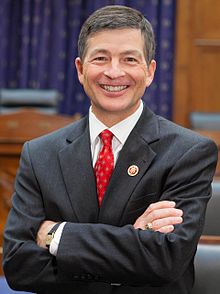By Jim Ellis — Wednesday, July 9, 2025
House
Over the 4th of July break we saw at least 17 individuals announce their congressional candidacies, 10 of which are worth mentioning from a competitiveness perspective. Many of the individuals became candidates over this past weekend as a show of patriotism over the national Independence Day holiday or in response to the “One Big Beautiful Bill’s” enactment.
The seven not worthy of discussion, including a Democratic challenge to Speaker Mike Johnson in Louisiana’s 4th Congressional District, involve candidates running in strong opposite party seats who prove no serious threat to their incumbent opponents.
The 10 districts listed below have the potential of hosting interesting races. The referenced partisan leans for each of the seats are the work of the Dave’s Redistricting App’s statisticians. The Trump-Harris figures reveal the percentage each 2024 presidential candidate received in the particular district.
1. AZ-5 (58.5R – 39.6D; Trump 63.9 – Harris 34.8%)
While Arizona’s 5th District, wholly contained in Maricopa County, appears solidly Republican, Democrats appear ready to challenge for the seat since the CD will be open in the 2026 election. The latest entry is Iraq War veteran Brian Hualde. He joins a field of five Democrats vying for the party nomination even though the eventual nominee will be a decided underdog in the special election.
Eight Republicans have entered the race. Rep. Andy Biggs (R-Gilbert) is leaving the House to run for Governor. The Arizona primary is scheduled for Aug. 4, 2026.
2. CA-3 (52.5R – 45.6D; Trump 50.3 – Harris 46.5%)
Two-term Rep. Kevin Kiley (R-Rocklin/Sacramento) has drawn his second 2026 Democratic opponent. Marine Corps veteran and Jeopardy! game show winner Tyler Vandenberg joined a Democratic congressional field that already features Nevada County Supervisor Heidi Hall. The general election again figures to be contested, but Rep. Kiley remains the favorite to score another victory in the low to mid 50s. The California jungle primary will be held June 2.
3. CT-1 (60.8D – 36.6R; Harris 60.6 – Trump 37.7%)
Veteran Rep. John Larson (D-Hartford) has drawn a Democratic primary challenge from Hartford School Board member Ruth Fortune in one of several campaigns where the candidates’ age discrepancy will be a major issue. Rep. Larson is 77 years old with some health issues, while Fortune is 37. This could be a primary to watch. The Connecticut primary will be held Aug. 11, 2026.
4. FL-23 (56.5D – 42.3R; Harris 50.5 – Trump 48.6%)
In a Democratic seat that GOP leaders are attempting to make competitive, businessman Jared Gurfein became the fifth Republican to enter the primary in hopes of challenging two-term Rep. Jared Moskowitz (D-Parkland).
While the district has lately been trending slightly more toward the Republicans than the electorate’s longer term voter history suggests, Rep. Moskowitz will likely be cast as a decided favorite to win another term in the low to mid 50s. The only Republican candidate with electoral experience is former state Rep. George Moraitis.
5. NE-2 (50.1R – 47.1D; Harris 51.6 – Trump 47.0%)
With five-term Rep. Don Bacon (R-Papillion/Omaha) retiring, this Omaha anchored district is moving leftward and will be a top Democratic conversion opportunity. As expected, former state Senator and ex-gubernatorial candidate Brett Lindstrom (R) announced his candidacy. This contest will develop into a hard-fought, close campaign. The parties will choose their nominees on May 12, 2026.
6. NJ-12 (63.9D – 34.3R; Harris 60.6 – Trump 36.7%)
This is another campaign where the incumbent’s age versus that of her opponent will be an issue. Businessman Kyle Little (D) claims to respect 80-year-old New Jersey Rep. Bonnie Watson Coleman (D-Ewing Township) but at 36, Little says he would be much more able to serve the constituency. Rep. Watson Coleman remains a heavy favorite for the June 2, 2026 New Jersey congressional primary election.
7. TN-6 (61.4R – 36.4D; Trump 67.0 – Harris 31.8%)
With Rep. John Rose (R-Cookeville) running for Governor, the Congressman’s chief of staff, Van Hilleary (R) who himself served as the state’s 4th District Congressman from 1995-2003, announced that he will return to the elective politics circuit and attempt to succeed his current boss. Several state legislators are expected to join the race, but so far Hilleary would only face minor candidates. The eventual GOP nominee will be a lock in the general election.
8. TN-7 (55.1R – 42.1D; Trump 60.4 – Harris 38.1%)
With Rep. Mark Green (R-Clarksville) resigning from the House on July 20, the first Democratic candidate filed with the Federal Election Commission. State Rep. Aftyn Behn (D-Nashville) officially entered the special election and several others will soon be following suit.
Three Republicans have declared their candidacies: Former state cabinet official Matt Van Epps, Montgomery County Commissioner Jason Knight, and state Representative Jay Reedy (R-Erin) all declared soon after Rep. Green indicated he would leave the House midterm.
While Democrats clearly are making an effort to run, the eventual Republican nominee will be the clear favorite in the special general election. Once Green officially leaves office, Gov. Bill Lee (R) will have 10 days to announce the special election calendar.
9. VA-1 (54.1R – 44.1D; Trump 51.8 – Harris 46.9%)
Democrats have interest in challenging Rep. Rob Wittman (R-Montross) because the 1st District is the only Virginia Republican congressional seat where President Trump’s percentage degraded compared with 2020.
This being the case, attorney and Army veteran Mel Tull became the third Democrat to enter the primary. He joins Chesterfield Circuit Court Clerk Amanda Pohl and corporate executive Lisa Vedernikova Khanna in the Democratic primary that will either be decided by a primary election or district convention in mid-June of next year. Despite Trump’s downturn, Rep. Wittman will again be favored for re-election.
10. WA-8 (49.9D – 48.4R; Harris 51.3 – Trump 45.5%)
Washington’s 8th District always has the potential of being competitive, and four-term Rep. Kim Shrier (D-Sammamish) has had her share of close finishes. Over the weekend, she drew a new Republican opponent for next year’s election. Two-time statewide candidate Bob Hagglund is now officially in the race. Rep. Shrier will be comfortably favored despite being in a district that could yield a very tight race. The Washington jungle primary is scheduled for Aug. 4, 2026.






